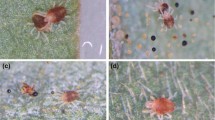Abstract
Closely related species often show adjacent geographic distributions, albeit with some overlap. This contiguity is thought to result from secondary contact between (spatially separated) diverging groups or from parapatric speciation. Fights between males of closely related species will affect their chance to mate with females of the other species, which in turn may promote their spatial segregation and drive their speciation. Stigmaeopsis miscanthi is a social spider mite that lives in a group within self-woven nests on leaves of Chinese silver grass. This mite shows lethal male–male fight as a means to maintain a harem, and has two forms showing differences in the levels of male–male aggression, diapause intensity in females and the relative length of the first to third legs. The two forms show parapatric distributions. We found that males of one form readily engage themselves in lethal fight with males of the other form, thereby acquiring the nests and gaining access to females of this other form. Males of the aggressive form tend to win the fights with males of the other form. Their first legs are longer which may provide them with a better weapon and which also indicate a larger body width. However, another determinant of who wins the fight is the length of the third legs which can be a proxy for body length. Based on these results, we hypothesize that male killing behavior is one of the mechanisms maintaining parapatry (instead of sympatry) of the two spider mite forms apart from difference in diapause attributes.






Similar content being viewed by others
References
Andersson M (1994) Sexual selection. Princeton University Press, Princeton
Coyne JA, Orr HA (2004) Speciation. Sinauer Associates, Inc., Massachusetts
Gröning J, Hochkirch A (2008) Reproductive interference between animal species. Q Rev Biol 83:257–282
Ito K, Fukuda T (2009) Molecular phylogeny of Stigmaeopsis spider mites (Acari: Tetranychidae) based on the Cytochrome Oxidase subunit I (COI) region of mitochondrial DNA. Appl Entomol Zool 44:343–355
Kuno E (1992) Competitive exclusion through reproductive interference. Res Popul Ecol 34:275–284
Saito Y (1990a) ‘Harem’ and ‘non-harem’ type mating systems in two species of subsocial spider mites (Acari, Tetranychidae). Res Popul Ecol 32:263–278
Saito Y (1990b) Factors determining harem ownership in a subsocial spider mite (Acari: Tetranychidae). J Ethol 8:37–43
Saito Y (1994) Do males of Schizotetranychus miscanthi (Acari, Tetranychidae) recognize kin in male competition? J Ethol 12:15–17
Saito Y (1995) Clinal variation in male-to-male antagonism and weaponry in a subsocial mite. Evolution 49:413–417
Saito Y (1997) Sociality and kin selection in Acari. In: Choe JC, Crespi BJ (eds) The evolution of social behavior in insects and arachnids. Cambridge University Press, London, pp 443–457
Saito Y, Sahara K (1999) Two clinal trends in male–male aggressiveness in a subsocial spider mite (Schizotetranychus miscanthi). Behav Ecol Sociobiol 46:25–29
Saito Y, Sakagami T, Sahara K (2002) Differences in diapause attributes between two clinal forms distinguished by male-to-male aggression in a subsocial spider mite, Schizotetranychus miscanthi Saito. Ecol Res 17:645–653
Saito Y, Mori K, Sakagami T, Lin J-Z (2004) Reinstatement of the genus Stigmaeopsis Banks, with descriptions of two new species (Acari, Tetranychidae). Ann Entomol Soc Am 97:635–646
Sakagami T, Saito Y, Kongchuensin M, Sahara K (2009) Molecular phylogeny of Stigmaeopsis, with special reference to speciation through host plant shift. Ann Entomol Soc Am 102:360–366
Sato Y, Saito Y, Mori K (2000a) Reproductive isolation between populations showing different aggression in a subsocial spider mite, Schizotetranychus miscanthi Saito (Acari: Tetranychidae). Appl Entomol Zool 35:605–610
Sato Y, Saito Y, Mori K (2000b) Patterns of reproductive isolation between two groups of Schizotetranychus miscanthi Saito (Acari: Tetranychidae) showing different male aggression traits. Appl Entomol Zool 35:611–618
Sato Y, Saito Y, Sakagami T (2003) Rules for nest sanitation in a social spider mite, Schizotetranychus miscanthi Saito (Acari: Tetranychidae). Ethology 109:713–724
Sato Y, Saito Y, Chittenden AR (2008) The parapatric distribution and contact zone of two forms showing different male-to-male aggressiveness in a social spider mite, Stigmaeopsis miscanthi (Saito) (Acari: Tetranychidae). Exp Appl Acarol 44:265–276
Yano J, Saito Y, Chittenden AR, Sato Y (2011) Variation in counterattack effect against a phytoseiid predator between two forms of the social spider mite, Stigmaeopsis miscanthi. J Ethol 29:337–342
Acknowledgments
We appreciate Prof. Yutaka Saito at Hokkaido University for spider mite collection and advice. We also thank Dr. Paul van Rijn for his comments on this paper. Two anonymous reviewers provided comments that greatly improved our manuscript. This work was supported by Research Fellow of the Japan Society for the Promotion of Science (No. 21.1045).
Author information
Authors and Affiliations
Corresponding author
Rights and permissions
About this article
Cite this article
Sato, Y., Sabelis, M.W. & Mochizuki, A. Asymmetry in male lethal fight between parapatric forms of a social spider mite. Exp Appl Acarol 60, 451–461 (2013). https://doi.org/10.1007/s10493-013-9668-8
Received:
Accepted:
Published:
Issue Date:
DOI: https://doi.org/10.1007/s10493-013-9668-8




